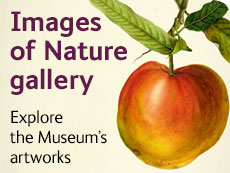Reconstructing the dodo
You need Adobe Flash Player, or an HTML5 enabled web browser, and JavaScript enabled to watch this video.
Visit the Adobe website to download the latest Adobe Flash Player
Most people think they know what the dodo looked like. It’s the one we see in books and films and on television. It’s also the classic model we see on display in the Museum’s Bird gallery. We now think the dodo looked somewhat different.
We can trace the iconic image back to the bird seen in paintings from the late 1620s by the Flemish painter Roelandt Savery. Although the dodo was not yet extinct in Savery’s day, it is not known if he actually saw a living bird or instead worked from material and descriptions brought back by mariners who had visited Mauritius.
The first reconstruction
The classic reconstruction of the flightless bird was put together some 200 years after it became extinct. Richard Owen, founding superintendent of the Natural History Museum, received the first fossil dodo bones in 1865.
He put the fossil bones together in the way he thought the bird would have looked, the way Savery portrayed it. He used an outline of the bird taken from the painting and arranged the bones inside it. This and his detailed scientific description of the bird were published in Owen’s book on the dodo and cemented its image for generations to come.
Three years later, Owen realised he’d got it wrong. His later reconstructions show a much more natural looking upright bird but he was too late to change the popular public view.
Recent interpretations
Recent discoveries of fossils on Mauritius have confirmed how scientists now think the dodo looked. The neck and breast would almost certainly have been thinner and more graceful. Because the bird didn’t fly, it wouldn’t have needed large muscles in its breast. It may have looked rather snake-like instead of fat and bulbous. This is the dodo you can see in the paintings of Julian Pender Hume, avian paleontologist, artist and the Museum’s dodo expert. One is on display in the Museum's Images of Nature gallery.
Art, nature and imaging

Discover how natural history art and imaging techniques have developed since the 17th century and explore selected artworks from the Museum’s world-class art collections.
